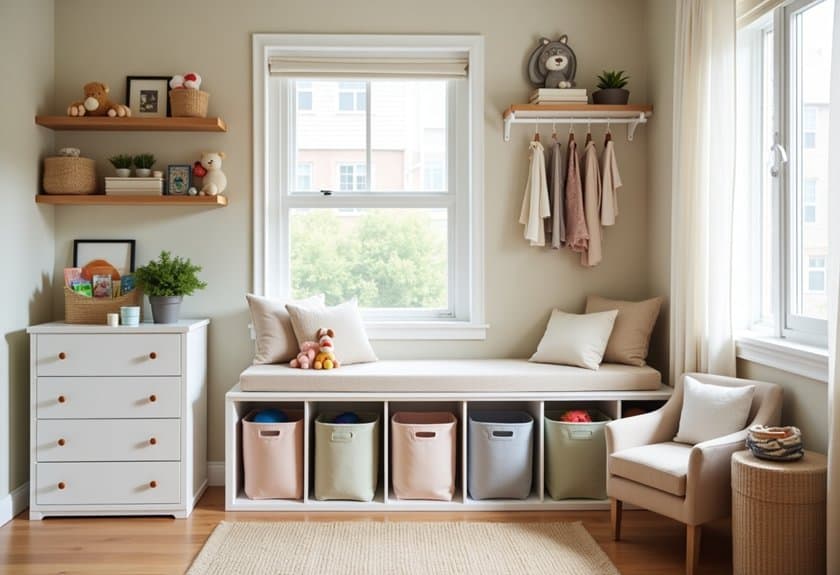Just like building blocks that stack perfectly to create a stable tower, organizing a toddler’s bedroom requires the right foundation and careful planning. You’re probably familiar with the daily tornado of toys, books, and clothes that seems to sweep through your little one’s space! I’ve helped countless parents transform chaotic kid zones into functional sanctuaries that actually stay tidy (yes, it’s possible). If you’re ready to reclaim your sanity and teach your toddler valuable organization skills, these parent-tested solutions will revolutionize your approach to kid-space management.
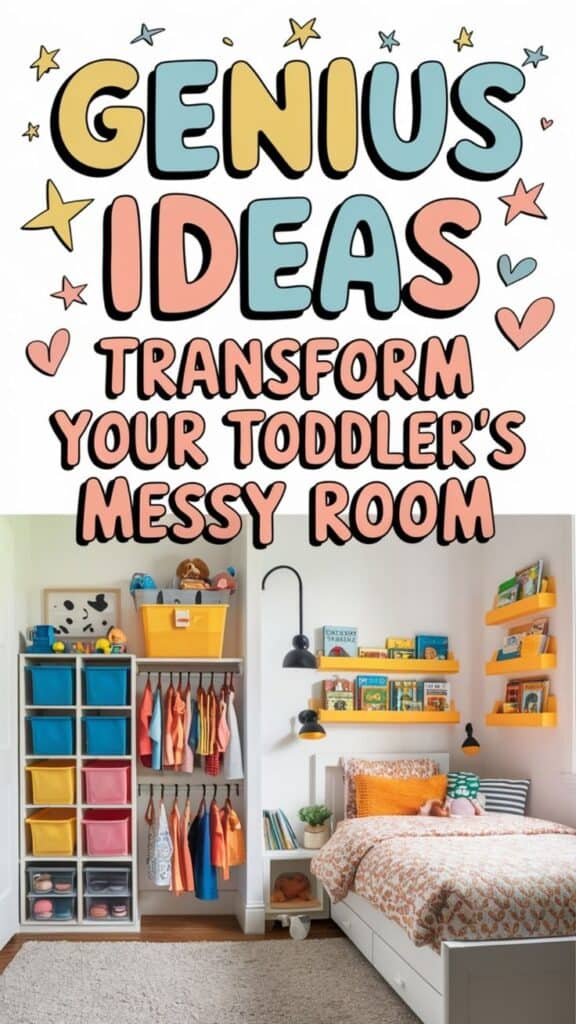
Zone Planning: Creating Designated Areas for Sleep, Play, and Storage
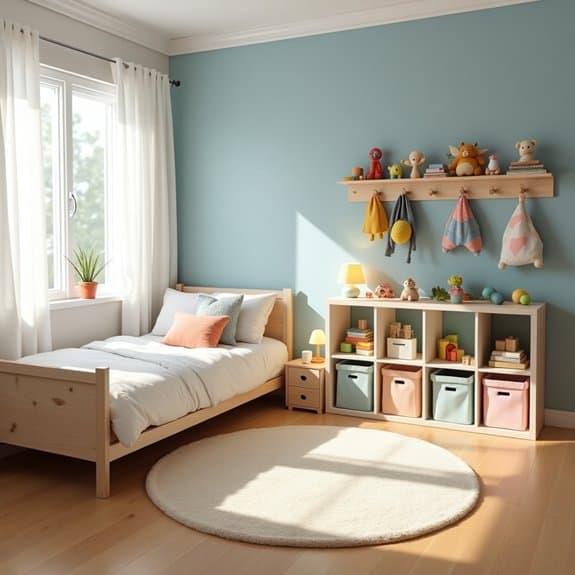
Creating distinct zones in a toddler’s bedroom is essential for establishing routines, promoting independence, and maintaining order. Well-defined areas help young children understand the purpose of different spaces while making it easier for them to transition between activities throughout the day.
Proper zone planning allows toddlers to develop spatial awareness and learn organizational skills early in life. When each area has a clear purpose – sleeping, playing, or storing belongings – children can better understand expectations and participate in maintaining their space, leading to improved behavior and self-regulation.
Required Items:
- Area rug to define play space
- Bed or crib
- Storage bins and baskets
- Toy organizers
- Bookshelf
- Labels or pictures for organizing
- Child-height hooks
- Cushions or soft seating
- Storage furniture
- Room dividers (optional)
Start by mapping out the three primary zones: sleep, play, and storage. Position the bed against a wall away from windows and direct sunlight, creating a calm sleep zone with minimal distractions. Place soft lighting and perhaps a small bookshelf nearby for bedtime routines.
Establish the play zone in the room’s brightest area, using an area rug to define the space. Include low shelves or bins for toys that are easily accessible to your toddler.
For the storage zone, utilize vertical space with shelving units and cubby systems. Install child-height hooks for frequently used items and incorporate closed storage for items requiring adult supervision. Keep frequently used items at toddler height and less-used or seasonal items higher up. Consider using picture labels to help your toddler identify where items belong.
Additional Tips: Maintain flexibility in your zone planning by using mobile storage solutions and furniture that can be easily rearranged. Regularly rotate toys between accessible and stored locations to prevent overwhelming your toddler and maintain interest in their belongings.
Consider implementing a simple clean-up routine that corresponds to each zone, making it easier for your toddler to maintain their organized space.
Accessible Storage Solutions That Grow With Your Child
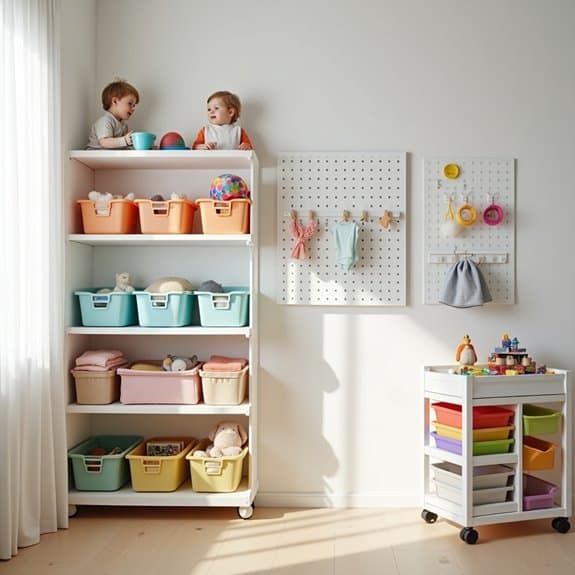
Creating adaptable storage solutions in a toddler’s bedroom is crucial for their developing independence and learning. When storage is accessible and age-appropriate, children can actively participate in cleaning up, finding their belongings, and developing organizational habits that will benefit them for years to come.
Well-planned storage systems should evolve as your child grows, accommodating changing needs from the toddler years through early childhood. The key is implementing solutions that can be easily modified in height, capacity, and function while maintaining a safe and organized environment that encourages self-sufficiency.
Required Items:
- Adjustable shelving units
- Low-height storage bins
- Clear containers
- Label maker
- Picture labels
- Wall-mounted storage rails
- Adjustable closet rods
- Canvas storage cubes
- Rolling storage carts
- Child-safe mounting hardware
Start by installing adjustable shelving units at your toddler’s current height level, placing frequently-used items within easy reach. Install wall-mounted storage rails low enough for your toddler to access, using picture labels to identify designated spots for different items. Incorporate clear storage bins on lower shelves so children can see their contents, and position heavier items on bottom shelves for safety.
For closet organization, install an adjustable closet rod at toddler height, with a second rod above for future use or parent-accessed items. Use canvas storage cubes with picture labels for toys and clothes, allowing your child to sort items independently. Position rolling storage carts under windows or in corners, ensuring they can be easily moved during cleaning or room rearrangement.
Additional Tips: Regularly assess your storage system’s effectiveness and adjust heights and configurations as your child grows. Use color coding to make organization more engaging and intuitive for young children. Keep a rotation system for toys and clothes, storing out-of-season or less-used items in higher spaces while maintaining current items within reach. This prevents overcrowding and maintains an organized space that can be effectively managed by both parent and child.
Multi-Purpose Furniture Picks for Small Spaces
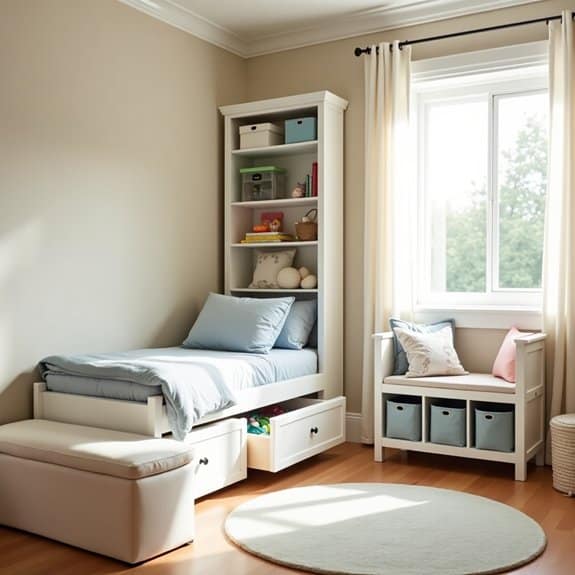
Making the most of limited space in a toddler’s bedroom requires strategic furniture choices that serve multiple functions. Multi-purpose furniture not only maximizes square footage but also helps maintain organization while accommodating your growing child’s changing needs.
The right combination of dual-function pieces can transform a cramped room into an efficient space for sleeping, playing, and storage. When every piece of furniture works double-duty, you create more open floor space for playtime while ensuring essential items remain organized and accessible.
Required Items:
- Bed with built-in storage drawers
- Ottoman with storage compartment
- Bookshelf with toy bins
- Desk/craft table with storage cubbies
- Wall-mounted folding table
- Storage bench
- Convertible chair/bed
- Stackable storage containers
- Labels
- Measuring tape
Begin by measuring your toddler’s room and creating a floor plan that maximizes corner spaces. Place the bed with storage drawers against the longest wall, utilizing the under-bed space for seasonal clothing or extra bedding.
Position the storage bench under a window to create a reading nook while storing books or toys inside. Install a wall-mounted folding table that can serve as both a desk and craft area, folding flat when not in use.
Select furniture pieces that grow with your child. A bookshelf with removable toy bins can later accommodate school supplies and books. Choose an ottoman that opens for quick toy cleanup during the day and serves as extra seating.
Ensure all storage solutions are easily accessible at toddler height, with heavier items stored in bottom drawers or cubbies.
Additional Success Tips:
Rotate toys and books stored in multi-purpose furniture regularly to maintain organization and keep your toddler’s interest. Use clear containers inside furniture compartments to separate categories of items, and implement a simple labeling system with pictures for toddler independence.
Regularly assess the functionality of each piece, adjusting the setup as your child’s needs change.
Toy Rotation Systems to Minimize Clutter
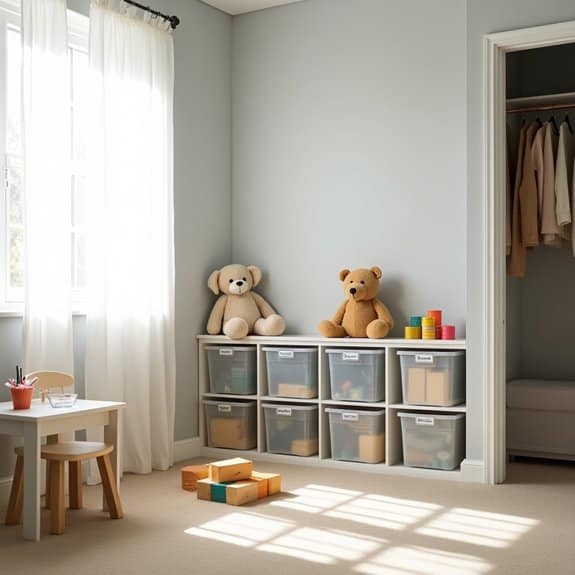
A toy rotation system is a game-changing solution for managing the overwhelming amount of toys that can quickly overtake a toddler’s bedroom. By implementing this organizational method, parents can reduce visual clutter, make cleanup easier, and help their toddlers focus better on playing with fewer toys at a time.
Research shows that children actually engage more meaningfully with their toys when presented with a limited selection. A rotation system not only keeps the space tidier but also makes old toys feel new again when reintroduced, extending their play value and reducing the constant demand for new items.
Required Items:
- Storage bins or boxes
- Labels or label maker
- Inventory list
- Storage space (closet, basement, or garage)
- Sorting containers
- Timer
- Plastic bags or containers for small parts
- Marker or pen
- Category dividers
Start by gathering all toys and sorting them into categories such as building blocks, pretend play, arts and crafts, vehicles, and educational toys. Remove any broken items, duplicates, or age-inappropriate toys. Create 3-4 separate collections of toys, ensuring each rotation includes a variety of play experiences and learning opportunities.
Store excess toys in clearly labeled bins in your designated storage area. Set up a schedule for rotating toys, typically every 1-2 weeks. When switching collections, involve your toddler in the process by making it a special event. Keep a master inventory list to track which toys are currently in rotation and which are in storage.
Always ensure that favorite comfort toys remain accessible and don’t become part of the rotation system.
Additional Tips: Consider seasonal rotations for certain toys, and use clear containers so children can see what’s inside without opening them. Maintain a “one in, one out” rule when acquiring new toys to prevent overflow. Document which toy combinations work best together and which toys get the most engagement.
This information will help you create more effective rotations in the future and inform future toy purchases.
Labels and Visual Guides for Easy Clean-Up
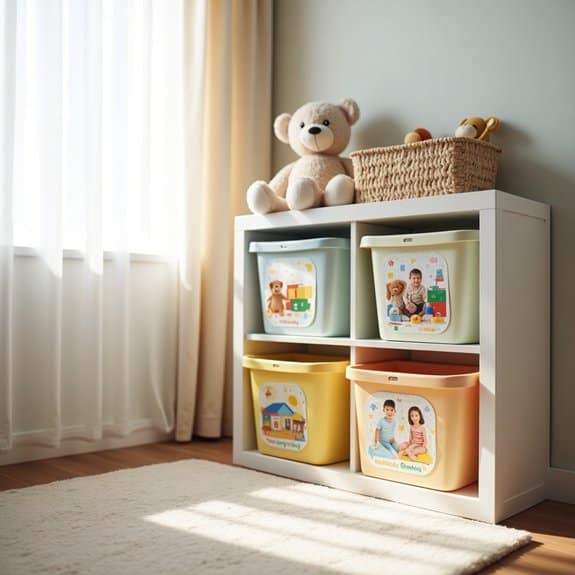
Teaching toddlers organizational skills early in life sets them up for long-term success with responsibility and independence. Clear labels and visual guides make it easier for young children to understand where items belong and help them participate in cleanup activities, even before they can read traditional text.
Visual organization systems reduce frustration for both parents and toddlers during cleanup time, as children can quickly identify where toys and belongings should go. This system also empowers toddlers to take ownership of their space and develops their confidence in completing tasks independently.
Required Items:
- Label maker or printer
- Clear adhesive label sleeves
- Picture cards or photos of toys and items
- Colorful bins or containers
- Clear packing tape
- Laminator (optional)
- Velcro dots (optional)
- Card stock paper
- Scissors
- Storage containers or shelves
Creating an effective labeling system starts with photographing or finding pictures of your toddler’s toys and belongings. Print these images in clear, recognizable sizes and pair them with simple words if desired. Laminate the pictures for durability and attach them to corresponding storage containers using clear packing tape or velcro dots.
Position labels at your toddler’s eye level and ensure they’re visible from where the child typically plays. Group similar items together and use consistent colors or symbols for different categories – for example, all building toys might’ve yellow labels, while stuffed animals use blue labels.
For maximum success, involve your toddler in the labeling process and create a simple cleanup routine that incorporates the visual guides. Regularly review and update labels as toys change or your child’s organizational needs evolve.
Consider creating a visual checklist or chart that shows the cleanup sequence, helping your toddler develop systematic cleaning habits.
Vertical Storage Strategies for Maximum Space
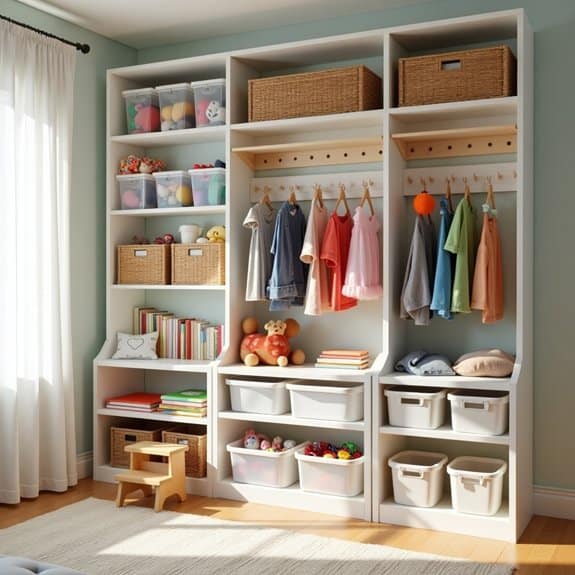
Making the most of vertical space in a toddler’s bedroom is essential for creating an organized, clutter-free environment. When floor space is limited, utilizing wall height effectively can double or triple your storage capacity while keeping toys, clothes, and supplies easily accessible.
Vertical storage solutions not only maximize space but also grow with your child. By implementing smart vertical storage systems, you can adjust shelf heights, reorganize containers, and modify storage solutions as your toddler’s needs change, ensuring long-term functionality and organization.
Required Items:
- Wall-mounted shelving units
- Over-the-door organizers
- Floating shelves
- Wall hooks and hangers
- Storage bins and baskets
- Cube organizers
- Label maker
- Anchoring hardware
- Measuring tape
- Level
- Stud finder
- Screwdriver and drill
Start by assessing your wall space and marking studs for secure mounting points. Install adjustable shelving units or cube organizers at varying heights, keeping frequently used items at your toddler’s eye level and occasional-use items higher up.
Mount floating shelves in a stepped pattern to create visual interest while maximizing corner spaces and awkward wall segments. Position over-the-door organizers on closet and bedroom doors to store shoes, accessories, and small toys.
Install hooks at child-height for backpacks, dress-up clothes, and frequently used items. Create designated zones by grouping similar items together vertically, such as books on lower shelves and seasonal clothing in higher storage bins.
Additional Success Tips:
Rotate items seasonally to maintain organization and prevent overcrowding. Use clear storage containers on higher shelves for easy identification, and implement a color-coding system for different categories of items.
Regular maintenance of vertical storage systems, including tightening hardware and adjusting shelf heights, will ensure safety and continued functionality as your toddler grows.
Daily Organization Routines That Work
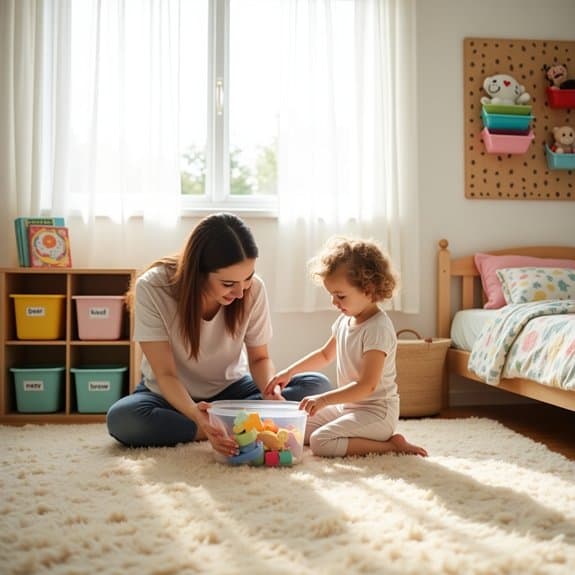
Establishing consistent daily organization routines in a toddler’s bedroom creates structure, promotes independence, and makes the space more manageable for both parents and children. When toddlers learn to participate in organizing their space, they develop essential life skills and begin understanding the importance of maintaining order in their environment.
A well-structured daily organization routine prevents the common chaos that often overwhelms toddler bedrooms. These routines transform overwhelming cleanup sessions into manageable daily tasks, reducing stress and creating more time for play and family activities. The key is implementing simple, age-appropriate systems that toddlers can follow and maintain.
Required Items:
- Labeled storage bins
- Picture labels for non-readers
- Toy sorting containers
- Laundry hamper
- Book rack or shelf
- Daily cleanup checklist
- Timer
- Reward chart
- Storage baskets
- Clear containers for small items
The daily organization process starts with morning basics: making the bed and placing pajamas in the hamper. Throughout the day, implement the “one-toy-out” rule, where toddlers must return one toy before taking out another.
Schedule two designated cleanup times – one before nap and one before bedtime. During these sessions, guide your toddler through specific zones: toys go in labeled bins, books return to shelves, and clothes either go in the hamper or dresser.
Create a visual cleanup chart featuring pictures of where items belong, allowing toddlers to follow along independently. Set a 10-minute timer for cleanup sessions to make the task less daunting and more game-like. Encourage participation by making cleanup a regular part of the daily routine, just like brushing teeth or getting dressed.
For maximum success, maintain consistency and offer positive reinforcement. Use a reward system for completed organization tasks, but keep it simple – stickers or extra storytime work well.
Adjust the routine as needed based on your toddler’s age and abilities, gradually increasing responsibilities as they demonstrate readiness. Remember that perfection isn’t the goal; building healthy organization habits is the primary objective.
Creative Book Storage and Display Ideas
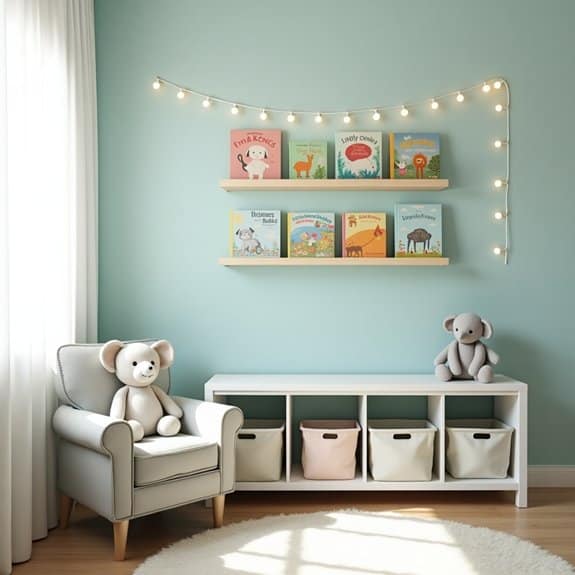
Creating an organized and accessible book storage system in a toddler’s bedroom is essential for fostering early literacy and developing a lifelong love of reading. When books are displayed attractively and within reach, children are more likely to engage with them independently, making reading a natural part of their daily routine.
Proper book organization also helps protect books from damage while making cleanup easier for both parents and toddlers. An effective storage system teaches children to care for their belongings while maintaining a clutter-free environment that’s conducive to reading and learning.
Required Items:
- Wall-mounted bookshelves
- Forward-facing book displays
- Storage bins or baskets
- Bookends
- Picture ledges
- Labels or category markers
- Mounting hardware
- Level
- Screwdriver
- Wall anchors
- Measuring tape
Start by assessing your toddler’s current book collection and sorting them by size, theme, or reading level. Install wall-mounted shelves at your toddler’s height, ensuring they’re properly secured with wall anchors.
Position forward-facing book displays to showcase attractive covers, which naturally draw children’s attention and make book selection easier. Create designated zones for different types of books: bedtime stories near the bed, educational books in a learning corner, and favorite series grouped together.
Use sturdy bins or baskets on lower shelves for board books and frequently accessed titles. Implement a rotating display system, changing featured books weekly to maintain interest and prevent overwhelming your toddler with too many choices at once.
Additional Tips: Consider implementing a color-coding system or picture labels to help your toddler maintain organization independently. Keep frequently read books within easy reach and store special or seasonal books in higher locations for parent-supervised access.
Regularly assess the organization system and adjust it as your child grows and their reading interests evolve. Remove damaged books promptly for repair or replacement to maintain an inviting reading environment.
Smart Closet Organization for Tiny Wardrobes
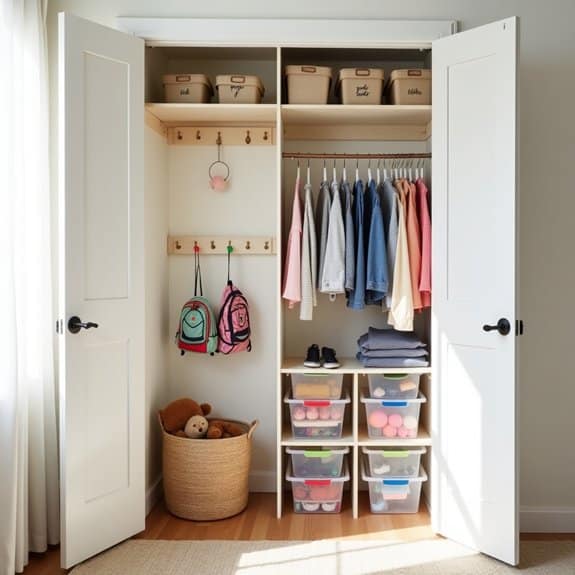
A well-organized toddler closet is essential for maintaining order in a child’s bedroom and making daily routines smoother. When dealing with limited closet space, every inch must be utilized efficiently to accommodate growing wardrobes and changing seasonal needs. Proper organization helps parents quickly locate outfits and ensures clothes remain accessible for independent dressing as toddlers develop these skills.
Maximizing a small closet’s potential requires strategic planning and the right organizational tools. By implementing a system that works for both current needs and future growth, parents can create a functional space that adapts to their toddler’s changing wardrobe while maintaining order in a compact area.
Required Items:
- Double hanging rod
- Small drawers or bins
- Over-the-door organizer
- Label maker
- Size dividers
- Clear storage containers
- Small baskets
- Child-height hooks
- Slim hangers
- Shelf dividers
Start by removing everything from the closet and sorting items by size, season, and type. Install a double hanging rod to instantly double the hanging space – use the upper rod for out-of-season or special occasion clothing and the lower rod for current, everyday items within your toddler’s reach.
Incorporate small drawers or bins at the bottom of the closet for shoes, accessories, and folded items like pajamas and undergarments.
Create designated zones within the closet using clear storage containers for items that are too big or too small, labeling each container clearly. Utilize over-the-door organizers for additional storage of small items like socks, hair accessories, or hats. Install hooks at your toddler’s height for frequently used items like jackets or backpacks.
Maximize success by implementing a regular maintenance schedule – review the closet’s contents every three months to remove outgrown items and adjust organization as needed.
Consider using color-coded hangers or labels to help your toddler participate in keeping their closet organized, fostering independence and teaching valuable organizational skills early on.
Under-Bed Storage Solutions for Extra Space
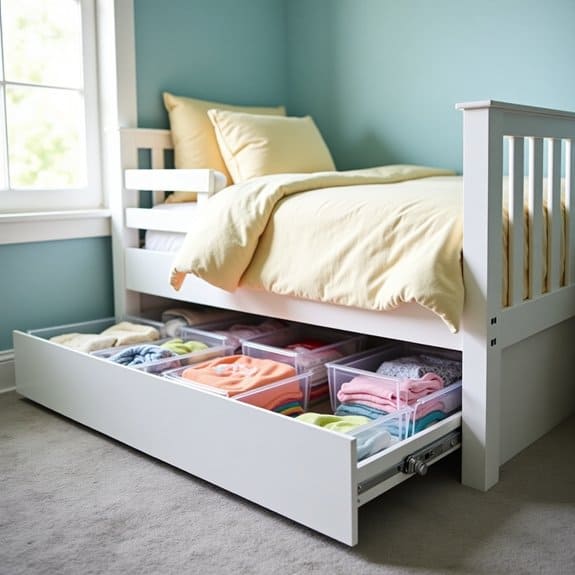
Making the most of under-bed space is crucial in a toddler’s bedroom, where square footage is often limited but storage needs are extensive. This often-overlooked area can accommodate seasonal clothing, extra bedding, toys, and learning materials while keeping them dust-free and easily accessible.
Strategic under-bed storage not only maximizes space efficiency but also teaches toddlers about organization from an early age. When items have designated spots beneath the bed, children can participate in cleanup time and learn to retrieve their belongings independently, fostering responsibility and spatial awareness.
Required Items:
- Under-bed storage containers with wheels
- Storage bags with zippers
- Bed risers (if needed)
- Labels or label maker
- Measuring tape
- Dust-proof covers
- Clear plastic bins
- Drawer organizers
- Storage baskets
Start by measuring the available space under the bed, including height, width, and depth. Select storage containers that maximize this space while allowing easy access. Organize items by category, placing frequently used items toward the front and seasonal items toward the back. Use clear containers for visibility and install wheels for smooth sliding.
Create zones under the bed – perhaps designating the right side for toys and the left for clothing. For optimal organization, label each container clearly with both words and pictures, making it easy for your toddler to identify contents. Consider using vacuum storage bags for bulky items like extra bedding or seasonal clothing to maximize space.
If additional height is needed, install bed risers to create more storage volume.
Additional Tips: Implement a regular maintenance schedule to prevent under-bed storage from becoming a catch-all space. Review contents every three months, rotating seasonal items and purging outgrown clothing or unused toys. Keep a small handheld vacuum nearby for easy cleaning, and consider placing a dust ruffle around the bed to conceal storage while maintaining easy access.

